EFAO Conference participants are invited to vote for their favourite on-farm innovation to win the 2021 Carrot Cache $1000 Innovation Prize.
Voting will be open until 3PM on Friday December 3rd. The winner will be announced the week after the Conference.
Innovation #1: Garden Cart Upgrade
We were starting our trays in a newly built germination chamber which is located in our main building. Once the trays were popped, they needed to be moved to our main greenhouse. This was a tedious task, either carrying trays by hand or using our larger garden/Vermont cart. While the cart improved efficiency, allowing staff to wheel over 6-7 trays, it still was a chore moving over 70 trays each load!
To improve the efficiency of moving trays, we built a platform for the cart that increased it’s holding capacity by 10 more trays! Instead of 11-12 trips back and forth from the germ chamber to greenhouse, we reduced this by half! Using scrap lumber from a dismantled composter and nails in the shop, there were no expenses just about an hour of labour.



Budget:
| Scrap Lumber | $0 |
| Nails | $0 |
| Total: | $0 |
Innovation #2: Seeding Helper
See a video of this innovation!
This is a tool for making holes in our plug tray cells. We only use one format of plug tray, but a similar style tool could be made for various tray dimensions. It’s a simple wooden board with nails pushed through such that when the board is pressed down over a plug tray filled with soil, small holes are presses into every cell at once. Makes seeding plug trays simpler as all you need to do after dropping in your seeds is to press the soil closed over the small hole. Modifications could easily be made to accommodate for different variables like if you use larger seeds, for example.
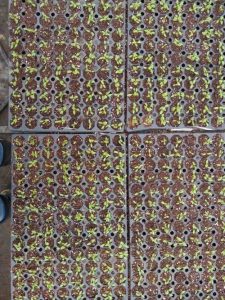


Budget:
| Wood | $20 |
| Nails | $5 |
| Total: | $25 |
Innovation #3: Bed/ Berm Maker
This is my very simple garden bed/berm maker. It creates a 30in bed with 12in paths on either side. it is built on runners like a sleigh so it can be pulled forward when it is filled and the next section of bed can be built. It is simple to make, easy to use, and makes a beautiful clean bed without the use of string lines. it can be used on straight lines or curves. if you are making a new bed you can place cardboard under it and fill the bed maker on top of the cardboard. If you are top dressing a bed with compost it also works great as you just fill the middle section and none of your compost gets wasted on the paths. The back bar smooths it all out as you pull it forward making it even and ready for planting. I used this tool to make berms across my pastures in our silvopasture plan and it was a game changer in terms of time and having a consistent clean bed at the end. It could also be adjusted to whatever size of bed and path combo you are working with on your farm.

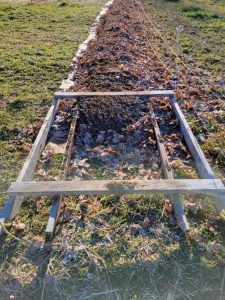
Budget:
| 2″ x 6″ x 10′ | $12 |
| 2″ x 4″ x 10′ | $7.50 |
| 2″ x 4″ x 8′ | $4 |
| screws | $0.50 |
| rope | $8 |
| Total: | $32 |
Innovation #4: A-Frame Leveler
This tool is an A-frame leveler. I am in the process of setting up a silvopasture food forest on a slope using keyline design. Keyline design allows me to capture, distribute, and store rainfall, making my food production more drought proof. The first step to this process is to find the contours on the land. This simple tool is similar to a compass used for measuring distance on a map. The two legs act as the points you are trying to match in elevation. The horizontal cross piece has a mark on it in the centre and hanging from the peak of the A, there is a string attached to a plumb bob. When the weighted string lines up with the mark on the horizontal cross piece the two leg points are level or on contour. This tool cost pretty much nothing as it is just scrap lumber, a string, a plumb bob, and some screws. It is simple to make, simple to use, and yet very effective for contour establishment for keyline design.



Budget:
| 3 – 1″ x 2″ x 8′ | $6.39 |
| string | $4 |
| plub bob | $10 |
| 5 screws | $1 |
| Total: | $21.39 |
Innovation #5: Laying Hen Rotation
Sleepy G Farm designed and implemented a system of integrating a flock of 100 layer hens into an organic vegetable crop rotation in order to accomplish three main objectives:
- Use the hen manure as a major fertility input on a field in the year prior to a heavy feeding vegetable crop.
- Aggressively add biomass to the soil while simultaneously stimulating nutrient cycling via highly active soil microbiology.
- Significantly reduce weed pressure on a field through a coordinated grazing and seeding schedule.
The project is based on a 143-day rotation that grazes 100 layer hens on a field 0.70 acres in size (400’ x 70’). At the onset of the season the field is seeded to a 12 species mix of annual plants that include both cool and warm season grains, legumes, and broadleaf crops. The field is divided into 4 equal blocks and uses electric netting to contain the hens to one block for 18 days at a time. Four chicken tractors provide shade, shelter, and nest boxes, and are easily moved by a single person every three days in order to evenly distribute manure across the grazing area.
As the hens move into a fresh grazing block the area from which they came is lightly tilled and re-seeded to the same mix. Overhead irrigation is used to achieve rapid germination. With warm summer soil and fresh fertilizer the second crop grows very rapidly! The hens graze off the second crop as they rotate back across the field. Once the field has been grazed twice the soil is again lightly tilled and seeded to winter rye by mid-September in order to anchor soil through the winter and to reduce nutrient leaching during spring melt.
In the spring the rye rapidly resumes growth by taking advantage of the latent fertility, and it is ploughed under in early June and covered with silage plastic which heavy-feeding cucurbits are transplanted through.
The following spring the field is planted to carrots, which benefit greatly from two consecutive seasons without a single weed getting established, and there is more than enough residual fertility to produce a yield of 30,000 lbs per acre.
After three seasons of using this system it has proven to be the cornerstone of the 6-year crop rotation in use on the farm. In addition to producing exceptional quality eggs and providing outstanding living conditions for the hens, feed costs are reduced by 1/3 during the grazing season, and the benefits to both soil structure and fertility plus the weed control it provides make this project a big win for Sleepy G Farm.


Budget:
| 2 x 165′ rolls of electric netting | $550 |
| 4 x 14′ x 6′ movable chicken tractors | $3,000 |
| 210 lbs seed | $115 |
| Total: | $3,665 |
Innovation #6: Shade Tunnel
Based off of Jean-Martin Fortier’s ‘Mini Tunnel’, the shade tunnel is constructed out of 12′ pieces of welded conduit, fitted over rebar, spaced at 5′ on the row and bent to arch over two standard sized 30″ beds. The design is based off of caterpillar tunnels and intended to use twine to fix plastic to the structure much like a miniature caterpillar tunnel.
Typically such a structure is somewhat redundant in the summer to be replaced by caterpillar tunnels and traditional greenhouses to grow heat loving crops that require vertical space to grow.
We repurposed our mini tunnels for growing mid-summer lettuce. They hold 12′ pieces (2x 6′ pieces stitched together with twine) of shade cloth to help reduce light and heat to assist in climatizing salad transplants in the 1-2 weeks after transplant.

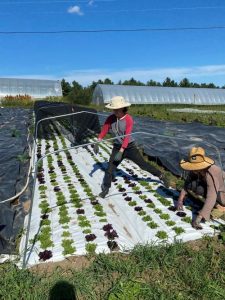

Budget:
| Rebar | $100 |
| Conduit | $300 |
| Shade Cloth (300′) | $600 |
| Zip-ties | $5 |
| Total: | $1,005 |
Innovation #7: Germination Chamber
Germination chamber built in the spring of 2021:
We got rid our inefficient warm frame in the fall of 2020 and needed a new space to house our many many trays of starts. This build was led by David Alexander, who built a germination chamber to not only improve the germination rate and time of many crops but also save on space. The chamber holds up to 80 trays and is mobile, so easy to shift it’s location.
Dave used plywood, foam board and EMT conduit to construct the chamber. The heat and humidity comes from a slow cooker with oil and a roasting pan filled with water. We also bought a SensorPush monitor to remotely monitor the temperature/humidity without having to open the doors. Our germination success is now almost 100% for certain crops and some crops like lettuces pop in only a couple days!!
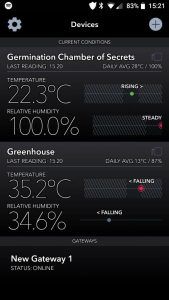


Budget:
| Plywood | $200 |
| Foam Board | $100 |
| EMT Conduit | $50 |
| Slow Cooker | $10 |
| Roasting Pan | $20 |
| Sensor | $80 |
| 2″ x 4″ Lumber | $300 |
| Total: | $760 |
Innovation #8: Solar-Powered Irrigation
Climate change and its impact on local communities creates challenges and opportunities for farmers to become more innovative and creative in how they incorporate sustainable agricultural development into their operations to meet the present and future needs of their community. It was important for us at Shade of Miti to understand how our farm and operations interact with and impact the local environment in a changing climate. Throughout 2021, we observed how water moves through our space, the impact drought has on our soil, and the beneficial and negative consequences our actions have on our local water ecosystem.
Traditionally, farmers at the site we are on have used storage tanks or generators at the on-site pond for irrigation. We implemented solar energy infrastructure at the pond to power and supply our irrigation system. Our system is simple yet extremely effective – it includes solar panels, a timer, pump and irrigation tubing which carries water up the hill to the field where it connects directly into our drip irrigation system. This system supports a cleaner and healthier pond habitat, allows us to be more in sync with the natural resources around us, and consistently reminds us of the importance of healthy and strong land-water relationships. The solar energy infrastructure has been so effective that we will be switching more of our farm operations to it next year! We recognize the importance of using our power and resources as a business, farm and community leader to ensure our actions do not contribute to our climate crisis.



Budget:
| Solar Panels | $280 |
| Pump | $180 |
| Timer | $20 |
| Back-up battery (if needed) | $100 |
| Misc. materials (wires, waterproofing, etc.) | $50 |
| Total: | $630 |
Innovation #9: Northern Vertical Farm
AgriTech North is an Indigenous-, disabled-, LGBTQ-owned indoor agriculture for-profit social enterprise corporation start-up with a mission to grow nutritious produce for Northwestern Ontario that is of a consistent quality, available year-round, and provided at a competitive price. AgriTech North will lower produce costs in Far North Indigenous communities by at least 25% and increase access to produce in communities that do not already have year-round access or storefronts. Food security and equity investment are diametrically opposed priorities; all other Ontario Greenhouses of moderate to large scale have equity investment and sell more than 70% of what they grow to the USA, illustrating how equity investment contributes to generating food security crises in Ontario. As such, we are highly reliant on grants to ensure viability and commit 100% of what we grow to Canadian citizens, with priority given to Indigenous communities.
To accomplish this, AgriTech North has a four-phase approach outlined in this AgriTech North Food Security Ecosystem Overview document. In 2021, AgriTech North is establishing Phase I operations at 250 Duke Street in Dryden, Ontario. There, we are utilizing a municipal surplus property to establish an innovative vertical farm technology to grow leafy greens and culinary herbs year-round as our first step towards providing Northwestern Ontario the food security it deserves. This vertical farm recycles water and nutrients in a drip hydroponic methodology, substantially reducing waste. In addition, we utilize no herbicides, pesticides, or herbicides in the facility, elevating our crop above Organic farming practices. We are soil-free as well, ensuring we do not contribute to soil erosion that is common to conventional techniques, and staved on Organic farms. Excess heat from the lighting is used to heat supporting spaces to the vertical farms, reducing reliance on natural gas. The vertical farm growing space is approximately 2,000 square feet and utilizes existing infrastructure, replacing what would require five or more acres of conventional farmland to produce a similar quantity of food, reducing the impact of conventional and Organic agriculture on our forests and tourism economy. AgriTech North is against single-use disposable plastic packaging and thus utilizes compostable packaging solutions.
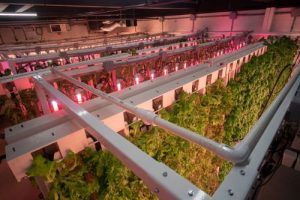

Budget:
| Vertical Farming Equipment | $473,318.28 |
| Other Equipment | $100,696.86 |
| Land/Building | $249,000.00 |
| Capital Improvements | $206,581.19 |
| Start-up Services | $48,630.00 |
| Working Capital | $163,076.26 |
| Total: | $1,192,721.22 |
Innovation #10: The Chicken Tugboat
The ‘Tugboat’:
A mobile, solar-powered feed cart which supplies food and water to 300 meat chickens per season. It is designed to carry roughly 150lbs of feed, approx. 60 gallons of water and any additional supplies or supplements for two 12’ x 10’ chicken tractors. This allows our pasture raised chickens to be completely self-sufficient out on pasture for days at a time, rather than being forced to remain close to water lines.

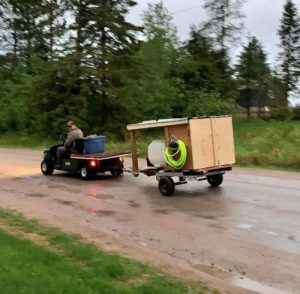
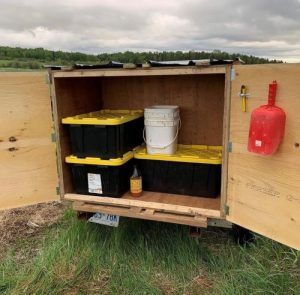
Budget:
| 60 gallon water tank | $60 |
| Hose, nozzle and reel | $100 |
| Car battery | $125 |
| Solar panel | $125 |
| Totes | $60 |
| Water pump | $125 |
| Wooden cabinet | $0 (scrap) |
| Axle with wheels | $0 (old boat trailer) |
| Total: | $595 |

